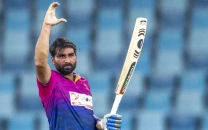Too many debutants spoil the broth
Since World Cup, Pakistan have a new captain with nine debutants entering the fray in a total of 17 games so far

Since the 2011 World Cup, Pakistan have handed out ODI caps to 29 players — the most for a leading team — with only a handful going on to become regular starters. PHOTO AFP
Subsequently, Misbah and veteran all-rounder Shahid Afridi retired from the 50-over format, while another seasoned pro, Younus Khan, was first ‘rested’ by the selectors before his hasty exit in the opening game of the ongoing ODI series against England.
Continuing the tradition of ‘rebuilding’ after World Cups, the selectors, in cohesion with the team management, have started handing caps to newcomers with unerring regularity.
Since the quarter-final defeat to Australia in Adelaide, Pakistan have had a new captain — Azhar Ali — with nine debutants entering the fray in a total of 17 games so far.
'Shehzad's exclusion from ODIs not due to disciplinary issues'
After the 2011 World Cup as well, Pakistan had introduced nine players inside a six-month span as Azhar benefited from the Mohsin Khan-led selection committee’s profligacy and won his maiden ODI cap against Ireland during this period.
Intriguingly, sans Azhar, none of the players could hold onto their ODI spot for long. Junaid Khan (52 matches) is the only one with 15 matches or more. However, a spate of injuries and poor form has seen him being sent packing from the squad too.
Test sensation Yasir Shah is the only player besides the captain with a spot in the squad that is engaged against England.
Earlier, after the humiliating first-round exit in the 2007 World Cup held in the West Indies, the Salahuddin Ahmed-led group of selectors handed ODI caps to as many as 13 players in a nine-month span.
Interestingly though, Sarfraz Ahmed and Wahab Riaz are the only two among Salahuddin’s ‘gang of 13’ that are part of the current ODI outfit.
Fawad Alam, Sohail Tanvir, Nasir Jamshed and Sohail Khan were all part of the same group that got their first taste of ODI cricket in a period that started on May 22, 2007 and ended on February 2, 2008, with the fifth home game against Zimbabwe staged at Sheikhupura Stadium.
Younus, Misbah named Advisors on Cricket Affairs
Meanwhile, Wahab and three others — Khurram Manzoor, Abdur Rauf, Rizwan Ahmed — were handed ODI caps in Sheikhupura.
Which boils down to this: ever since the 2011 World Cup, Pakistan have fielded 29 new players in the ODI format, the most for any top-ten team. Out of those 29, barring Anwar Ali, Yasir, Rahat Ali (part of the current team), only four (Junaid, Azhar, Haris Sohail and Sohaib Maqsood) have played more than 15 games.
Moving on, the 2015 debutants include Mohammad Rizwan, Saad Nasim, Sami Aslam, Babar Azam, Imad Wasim, Aamer Yamin, Bilal Asif, Iftikhar Ahmed and Zafar Gohar.
Zafar — who replaced the injured Yasir for the Sharjah game — and Iftikhar are the latest to join the club.
Iftikhar’s selection in the eleven for the second game against England last Friday puzzled many. The Peshawar-born 25-year-old had barely arrived in Abu Dhabi — as a replacement for the retired Younus — when he was included in the team at the expense of Bilal Asif.
Bilal, who snared the man-of-the-match award with an all-round performance in the decider against Zimbabwe in Harare last month, was asked to cool his heels after a solitary appearance against England.
All-rounder Yamin, who was fielded in all three Zimbabwe games, has also been confined to carry the drinks. In only his second ODI, the right-handed lower order batsman struck a whirlwind 62 to set up the prospects of an improbable win with Shoaib Malik.
Just like Bilal, he was fielded in only one more game.
Imad is part of the handful of success stories this year; unfortunately, he is nursing a finger fracture sustained during a domestic game last month.
Pakistan has no replacement for Misbah: Aamir Sohail
Azam, the prodigiously gifted right-handed batsman, has been yo-yoed in the batting order in his five appearances. After a match-winning unbeaten 62 in Abu Dhabi last Wednesday, the 21-year-old was inexplicably sent to bat as an opener in the following two games by the Waqar-Azhar think tank.
In his opening three games, Azam batted at number four — his knocks including a debut fifty— but was benched after one poor game against Sri Lanka at Pallekele.
Aslam played the third game of the Banglawash series, scoring 45 in an opening alliance of 91 with Azhar. Yet, he hasn’t played since.
Another extremely unlucky ‘newcomer’ is Lahore’s Saad Nasim. Handed an ODI debut in the same series as Sami, Nasim scored 77 in only his second game at Mirpur, rescuing the team from depths of despair at 77-5.
Nasim too was axed from the ODI and later the T20I team, with the selectors justifying his exit by stating that the batsman ‘needs to contribute more as a leg-spinner’.
All in all, Pakistan continue to fluctuate from bad to worse in the 50-over format, and the insatiable desire of introducing newcomers in the game without a proper run is certainly one of the reasons of the disaster.
Will Iftikhar and Zafar now meet the same fate as that of some of their compatriots?
Published in The Express Tribune, November 19th, 2015.
Like Sports on Facebook, follow @ETribuneSports on Twitter to stay informed and join in the conversation.



















COMMENTS
Comments are moderated and generally will be posted if they are on-topic and not abusive.
For more information, please see our Comments FAQ